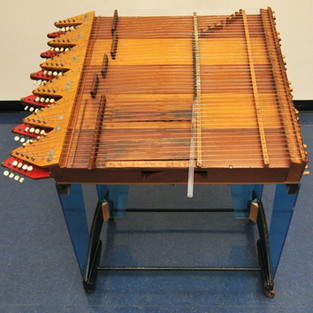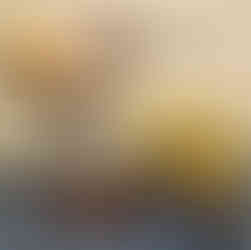Musical Innovations – Harry Partch Instruments
- Janae Jean

- Nov 30, 2020
- 10 min read
Updated: May 4, 2021
Inventor and Composer

In previous posts, we've focused on the instruments played in the conventional Western orchestra, some instruments from around the world, and some electronic instruments as well. In this post, we will explore the unconventional Harry Partch Instrumentarium and explore creating our own instrumental inventions.
Harry Partch (24 June 1901 – 3 Sept. 1974) was an American composer, music theorist, philosopher, as well as creator and builder of musical instruments. He composed using scales out of unequal intervals in just intonation and was one of the first 20th-century Western composers to work systematically with microtonal scales. Microtonal scales are made of intervals smaller than a half-step (also called a "semitone.") While the standard Western scale is divided in 12 half-steps, Partch divided it into 43 unequal intervals based on the harmonic series. Partch's earliest pieces were small-scale pieces to be recited to instrumental backing and his later works were larger theater productions, called "total-theater," in which he expected each of the performers to sing, dance, speak, and play instruments.

Partch was born in Oakland, CA and grew up in the American Southwest. During his childhood, he was exposed various musics from around the world. The idiosyncratic list of influences that Partch cited in his book, Genesis of Music, includes "Christian hymns, Chinese lullabyes, Yaqui Indian ritual, Congo puberty ritual, Cantonese music hall, and Okies in California vineyards, among others." Other influences included Japanese Noh and Kabuki and Ancient Greek theatre. He studied music theory and piano, as well as learning mandolin, violin, reed organ, and cornet. As a teen, he accompanied silent films on piano and composed music for drama. After high school, he entered the music composition program at the University of Southern California. After two years, he left USC and moved to San Francisco where he continued to study and compose and eventually rejecting the standard twelve-tone equal temperament of Western music. He read a translation of Sensation of Tone by German physicist and physician Hermann von Helmholtz (31 Aug. 1821 – 8 Sept. 1894) and discovered that just intonation better suited his compositional needs.
Partch was an outsider to the musical establishment throughout his life. While his early work garnered some support and small grants, the Great Depression forced Harry to spend many years as a transient. During this time, Partch collected the texts and experiences that would later form the basis for The Wayward: A collection of musical compositions based on the spoken and written words of hobos and other characters— the result of my wanderings in the Western part of the United States from 1934–1941. Listen to the dark "Barstow" from The Wayward in the video above. From 1941 to 1956, he composed and rewrote over a dozen works, invented and built over a dozen instruments, arranged several performances and recordings of his works, and wrote the first edition of Genesis of Music. From 1944 to 1947, Partch took up residence at the Unversity of Wisconsin. In 1956, Partch began residency at the University of Illinois where he found support for his compositions and performances until returning to the Western United States in 1962.

While he was productive and created many of his instruments and musical works and during his academic residencies, Partch who had not completed his degree at USC did not fit in in the academic environment and faced some oppositional from faculty although he did meet and work with some collaborators such as musician Danlee Mitchell who was Partch's assistant, ensemble manager, music director and conductor, personal consultant and manager, and friend until Partch's death.
Partch spent the last twelve years of his life in various locations along the California coast. These years would see more creative work, major productions of his total-theater pieces, and a greatly-expanded second edition of his book. Harry Partch died in Encinitas, California, on September 3, 1974 at age 73.
What is Just Intonation?

Just intonation is the way that ancient Greek philosophers explained music theory. It is a system of intervals constructed on whole integer ratios, rather than equal temperament. It naturally occurs as a result of the harmonic partials (also called the "overtone series") for simple systems, such as vibrating strings (see above) or air columns. This includes string instruments, wind instruments, and the human voice. Unfortunately, in just intonation, the tuning depends on the scale you are using. This means that the tuning for C major is not the same as for D major. Just intonation is often used by ensembles (such as for choral or orchestra works) as the players match pitch with each other "by ear." Equal temperament was invented so that instruments such as the piano would be able to play in any key and have a pleasing sound. Since traditional Western music instruments were not constructed with Partch's scales in mind, Partch invented and built his own instruments to perform his music.
Partch's Instruments

Partch did not begin as a musical instrument builder. He described himself as "a philosophic music-man seduced into carpentry."His earliest experiments with just intonation during the 1920s were written for traditional instruments, such as a string quartet in just intonation that is now lost.
Adapted Viola

The first of his instrumental innovations, the Adapted Viola, originally called the "Monophone" was built with the assistance of violin maker Edward Benton in 1930 in New Orleans. It has a cello neck attached to the body of a viola and a changeable bridge which allows for extended triple stops (three tones bowed at once).
Bloboy

The Bloboy is made of a powerful bellows that forces air through an antique auto horn and three organ pipes. Partch himself refers to the Bloboy as a "contraption, but one that gives a realistic impression of a passing freight train."
Adapted Guitars
Partch built two steel-string acoustic guitars. He first began experiments with adapted guitars in 1934. The Adapted Guitar I was a six-string guitar. It first appeared in Barstow in 1941. Incidentally, Barstow was inspired by hobo graffiti. The Adapted Guitar II had ten-strings and was played with a slide. Both of the instruments were later amplified in 1945.
Chromelodeons
The Chromelodeon I (1945) is an adapted reed organ that plays Partch's 43-tone per octave scale. The scale is in just intonation, and each tone is a frequency ratio to a fundamental, shown on the keyboard by colors. In addition to a standard keyboard and a collection of stops, it includes an additional keyboard of Partch’s own creation called the sub-bass. The total range of the instrument is from the lowest piano C to the third C# above middle C, slightly more than five acoustic octaves. All the other instruments in the Partch instrumentarium are tuned to the Chromelodeon. The Chromelodeon II (1946) is able to sound full triads with just one key pressed down. Additionally, Partch built another reed organ involving a keyboard similar to a typewriter in 1935, but he never used in it music.
Kitharas
The Kitharas gets their name from an ancient Greek instrument that is the ancestor to the modern guitar. In fact, the word "guitar"comes from "kithara." The Kithara 1 was built from 1938 to 1943. Then it was re-built in 1959. It is a lyre-type instrument with 72 guitar, tenor guitar, and banjo strings, and it has guitar tuning heads. The pitches are arranged in twelve hexads (groupings of six), each containing four to six identities of a tonality. Pyrex rods (5/8 inch) stop the two outside hexads for higher chords and gliding tones or chords. The Kithara II was built in 1954 and has different tunings than the Kithara 1. The Surrogate Kithara was built 1953. Each on the two resonators has eight strings. The higher is a major tonality, and the lower is a minor tonality. It can be played with picks, fingers, mallets, and felted sticks.
Koto

Partch's Koto is an adaptation of the Japanese plucked zither, given to him by fellow composer Lou Harrison (14 May 1917 – 2 February 2003). This Koto has some minor changes from a traditional koto, featuring an enhanced resonance and other modifications. It has thirteen nylon strings, stretched over easily-movable bridges. It was sed in 1955's The Bewitched.
Crychord

The Crychord is a monochord (one string instrument) that was originally invented by a student at the University of Illinois. The rod adjusts the tension of the string to change the pitch.
Marimbas
The first marimba above is the Zymo-Xyl. Three distinct types of sounds are possible on the Zymo-Xyl. The front resonator supports bars of white oak, the back resonator holds glass liquor and wine bottles, and on the side are two 1952 Ford hubcaps and one kettle top.
The Diamond Marimba is a prominent percussion instrument in many of Partch's works and is also a physical manifestation of one of his crucial theoretical concepts, the Tonality Diamond. The instrument contains all twelve of his primary tonalities, each laid out in a series of thirds. In total, the Diamond Marimba has 29 distinct pitches, each of which is a member of two or more tonalities. It was built in 1946 at Madison, Wisconsin. It has a range of almost three octaves, beginning with the approximate C# above middle C.
The Quadrangularis Reversum has a mirror reverse of the Diamond Marimba in the center, with an additional 21 alto bars. The sides are natural eucalyptus branches.
The Mazda Marimba is made of Mazda light bulbs and is named after the Zorastrian god of light, Ahura Mazda.
The Marimba Eroica was built from 1951 to 1955 at Mills College and at Gate 5, Sausalito, CA. Its largest resonator is 8 feet long, 4 feet high, and 14 inches wide. The plank above this is close to 8 feet long. All planks are mounted at the nodes on foam rubber. The player stands on a riser 14 inches high. The lowest gives an approximate F below the lowest piano A. Above this are (approximately) the lowest piano C, the lowest E, and the octave above the lowest A. The instrument is played with heavy padded mallets, and with hands in padded gloves. The resonators were designed and built by Bill Loughborough and Gerd Stern.
The Bass Marimba was built in 1950, near Gualala, California. It is 5 feet high (to the block level -- not including the music rack); 7.5 feet long. The longest block is 52 inches; the shortest 27 inches. The player stands on a riser 22 inches high. The resonators and frame are made of redwood. The blocks are vertical-grain Sitka spruce, mounted on foam rubber. It has eleven blocks that play pitches ranging from the low cello C to the B-flat below middle C (approximately). It is played with a variety of heavy and light mallets, bare hands (as in bongo drumming), felted sticks on the edges of the ends, and wire cream whippers.
The Bamboo Marimba I was built 1955-1956, at Gate 5, Sausalito, CA. The Bamboo Marimba II was built in 1971. They are also called the "Boo Marimbas." As the name implies, both of them are constructed with 64 bamboo resonators set in oak and plywood frames. The range is approximately from the B-flat below middle C to the second F above. Played with felted sticks and small mallets on the edges of the tongues. The instrument's design was based upon experiments made by Bill Loughborough.
The last marimba in the gallery above is the Eucal Blossom. It is another bamboo marimba with 33 resonators in three rows of eleven, supported by a branch of eucalyptus. It was first built in 1964.
Harmonic Canons
The Harmonic Canon 1 was built in 1945 at the University of Wisconsin. It was rebuilt at the University of Illinois. The resonating box, including the thin soundboards, was made of redwood. It has two sets of 44 strings each are strung on different planes. The first set, mostly guitar second strings,is horizontal. The second set, all tenor guitar first strings, dips from a high nut at the right to a lower set of tuning pegs at the left. The two sets intersect about seven inches from the right. Consequently, the player can choose pitches from either set, or both together. The first set has guitar fourth and fifth strings on the lowest sixteen, and a Pyrex bar beneath them provides gliding tones.
The Harmonic Canon II was built in 1953, at Gate 5, Sausalito, CA. Itt was built out of a redwood frame; thin vertical-grain Sitka spruce soundboards, oak ends on the resonating chambers, spruce bridges, mandolin tuning heads fixed on strap brass. Guitar second strings on Pollux (right) guitar second and fifth strings on Castor (left). It has 44 strings on each, with specific bridges especially made for each composition.
The Harmonic Canon III, also called the "Blue Rainbow", has two resonating boxes with 44 strings across the top. These rest on a frame supported by a blue arch, both giving the instrument its name and allowing the canons to bounce and sway while being played. It also uses specific bridges for specific compositions.
Gongs/Bowls
The Cloud Chamber Bowls were first built in 1950. They are made from a set of 12-US-gallon (45 L), 16-inch diameter Pyrex bowls, suspended in a frame. The bowls were originally sourced from the Berkeley Radiation Laboratory where they were used in the construction of cloud chambers. A cloud chamber, also known as a Wilson cloud chamber, is a particle detector used for visualizing the passage of ionizing radiation. The bowls give a bell-like tone, and each has at least one inharmonic overtone.
The Gourd Tree and Cone Gongs were first built in 1964. It consists of twelve temple bells bolted to gourd resonators on a bar of eucalyptus and two Douglas Aircraft bomber nose cones.
The Spoils of War was built from 1950 to1955, near Gualala, and at Gate 5, Sausalito, CA. The single resonator is 5 feet high. The 27-inch Pernambuco block above the resonator sounds an A, one octave above the piano's lowest A. The small redwood block in front gives an approximate C#, third above middle C. The seven brass artillery casings give a microtonal sequence from a flat C#, third above middle C, to the next D. The two cloud-chamber bowls are separated by about a semitone A and A-flat. The whang-gun, on the left, is a piece of spring steel controlled by a pedal, and makes a 'whang" sound. The raspador is also on the left. It is played with a variety of mallets.
Harry Partch Instrument's Today
The Partch instruments have been housed at the University of Washington in Seattle since 2014. In the video below, Charles Corey, curator of the Partch instruments gives a tour of the instruments and the unique sounds they make and iconoclastic musical notations which Partch invented for the performers to be able to play his compositions.
Although Partch passed away in 1974, composers may choose to compose for his instruments. Listen to "Crystal Paths 2" composed by Garth Knox for Partch's Bass Marimba and Baroque instrument, the viola d'amore. Played by Garth Knox plays the viola d'amore and Melia Watras, the bass marimba.
Others continue in Partch's iconoclast spirit and continue to keep microtonal music alive. Microtonal guitarist and composer John Schneider is the founder and director of the ensemble Partch (formeraly Just Strings). For Schneider microtonality is a passion. He says, for him, “All roads lead to Partch.” Composer Victoria Bond discusses writing for the Partch instruments in the video below.
Reflections and Impression Questions
What impression do you have of the Partch instruments? Would you compose for them? How would you use them? How do you think they can be most effective? Would you include them along with traditional instruments? Would you innovate your own instruments? How would you go about creating your own tonalities? How would you write down music for instruments such as these? How would you share such music?
Further Reading
Corey, Charles. Harry Partch. https://www.harrypartch.com/ (Accessed 30 Nov. 2020).
Corporeal Meadows: Photographs of Instruments Built By Harry Partch and Heard in his Recorded Music. https://www.corporeal.com/instbro/instintr.html (Accessed 30 Nov. 2020).
Microtonal Synthesis. Harry Partch Instruments. http://www.microtonal-synthesis.com/instruments.html (Accessed 30 Nov. 2020).
Partch Ensemble. http://partch.la (Accessed 30 Nov. 2020).
Schneider, John. Microtonal Guitarist. https://johnschneider.la (Accessed 30 Nov. 2020).
Suits, B. H., Physics of Music. https://pages.mtu.edu/~suits/Physicsofmusic.html (Accessed 30 Nov. 2020).
Janae J. Almen is a professional music instructor, composer, sound artist, and writer. She has a BA in Music/Education from Judson University and a MM in Computer Music/Composition from the Peabody Institute of the Johns Hopkins University. She is the founder of Perennial Music and Arts and is passionate about sharing her love of music and arts.
Partch Instrument Photos from www.HarryPartch.com


















































Comments